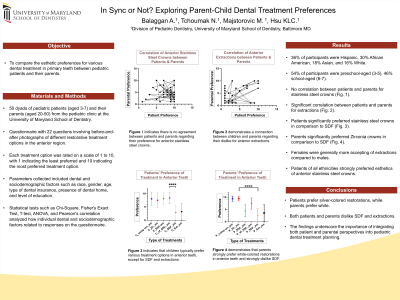Restorative
136 - In Sync or Not? Exploring Parent-Child Dental Treatment Preferences


Anuradha Balaggan, DDS
Pediatric Resident
University of Maryland, Baltimore
University of Maryland School of Dentistry
Baltimore, Maryland, United States- NT
Nikita Tchoumak, n/a
University of Maryland, Baltimore
- KH
Kuei Ling C. Hsu, n/a
Clinical Assistant Professor
University of Maryland, Baltimore
Baltimore, Maryland, United States 
Glenn Canares, DDS, MSD
Program Director, Pediatric Dentistry
University of Maryland School of Dentistry
Baltimore, Maryland, United States
Presenting Author(s)
Co-Author(s)
Research Mentor(s)
Program Director(s)
Purpose: To investigate the esthetic preference toward various dental treatment in primary teeth between pediatric patients and their parents.
Methods: Pediatric patients aged 3-7 and their parents were interviewed and demonstrated before and after photographs of various dental treatment for caries in primary teeth. The level of preference was measured with numerical scale. Treatment options included silver diamine fluoride (SDF), extractions, white crowns, white fillings, SSC and amalgam in both anterior and posterior teeth. Demographic data such as age, sex, race/ethnicity, and level of education (parents) were also collected. Chi-Square, Fischer exact, T test, ANOVA and Pearson’s test were used for statistical analysis. Significant level was set at 0.05.
Results: A total of 100 subjects were included. Significant correlation (P < .05) between parent-patient dyads on treatment for anterior extractions was observed. Interestingly, patients significantly preferred various restorative treatment options not limited to SDF in the anterior region (P < .05), where as parents significantly preferred Zirconia crowns in comparison to SDF (P < .05). A shared aversion towards SDF and extractions was observed in anterior teeth amongst parents and patients. However, no correlation was seen between patients and parents regarding their preference for anterior stainless steel crowns (P > .05).
Conclusions: The preference of dental treatment varies in the eyes of pediatric dental patients and their parents. This study underscores the importance of understanding these preferences for pediatric dentists in tailoring effective and acceptable treatment plans.
Identify Supporting Agency and Grant Number: Research supported by Division of Pediatric Dentistry, University of Maryland School of Dentistry

.jpg)